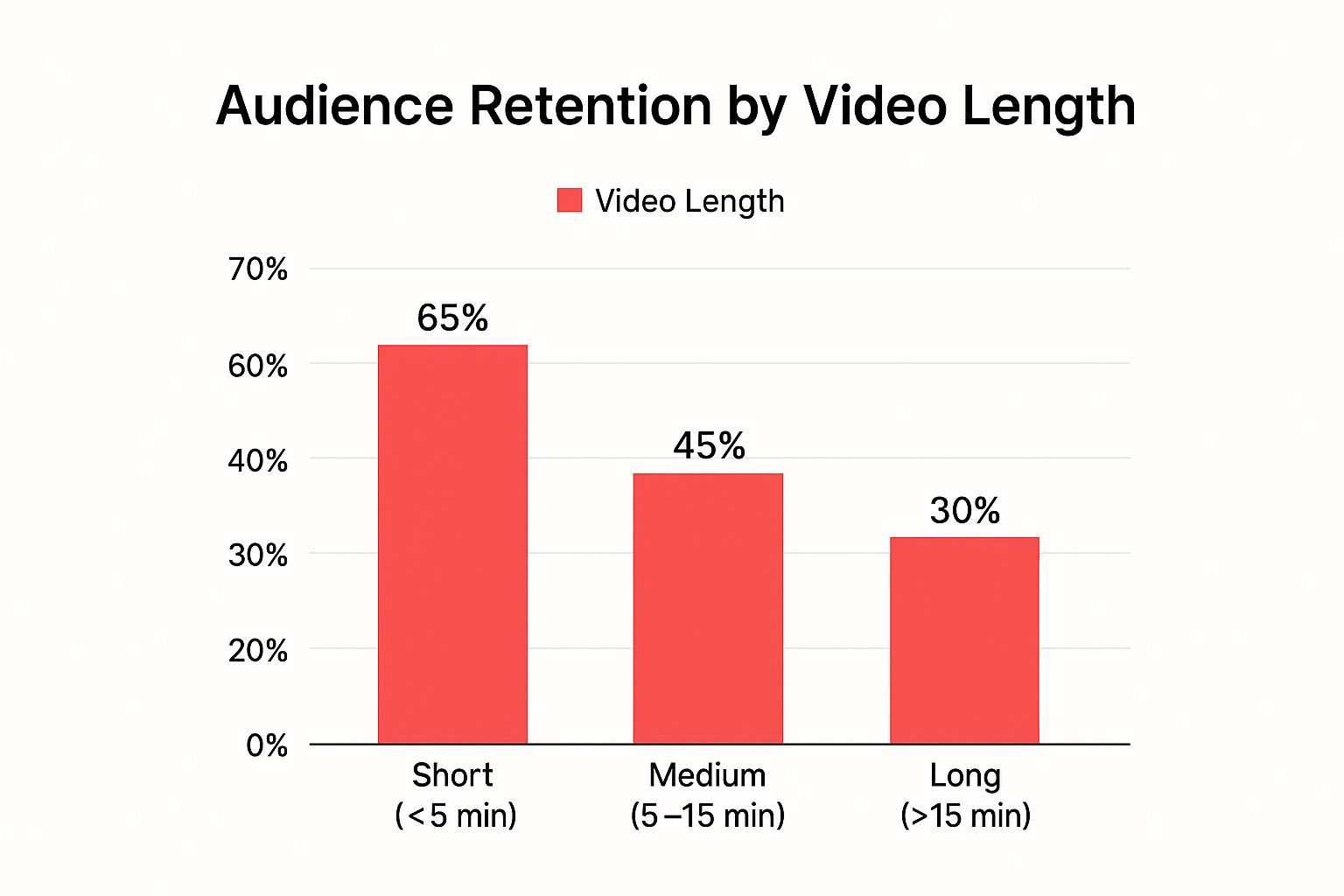If you're looking for a straight answer, here it is: the ideal YouTube video length often lands somewhere between 7 and 15 minutes. This window is long enough to pack in real value and hit those important mid-roll ad markers, yet it's short enough to keep most people from clicking away.
But the real answer is, it depends. The best length is whatever keeps your specific audience watching.
The Myth Of The Perfect Video Length
So many creators get hung up on finding that one magic number, a perfect runtime that unlocks guaranteed success. It's a tempting idea, but it’s a total myth. Chasing a specific minute count is like asking, "What's the perfect length for a book?" You wouldn't expect a kids' picture book to have the same page count as a historical epic, right?
The same logic applies directly to YouTube. The best video length isn’t some fixed target; it's a moving one that changes based on a few crucial factors:
- The Value You're Offering: Can your topic actually justify the runtime? A quick DIY hack probably only needs a few minutes. A deep-dive documentary on a complex subject? That’s going to need a lot more time to do it justice.
- What Your Audience Expects: Do your subscribers show up for quick, snappy updates, or are they there for your detailed, in-depth explorations? Your analytics will tell this story better than anyone.
- Your Channel's Goals: Are you focused on maximizing ad revenue? Then you’ll naturally lean towards videos longer than 8 minutes. Or is your goal rapid growth? In that case, shorter, more shareable content might be the smarter play.
When you start thinking this way, the question shifts from "How long should my video be?" to a much more powerful one: "How long can I hold my audience's attention while delivering on my promise?"
Finding Your Starting Point
Okay, so there's no single magic number, but that doesn't mean we're flying blind. Data from across the platform and insights from successful creators point to a reliable sweet spot. For many types of content, that 7 to 15-minute window is where you balance delivering comprehensive information without causing viewer fatigue.
Even though verified accounts can upload videos up to 12 hours long, a huge number of successful creators deliberately aim for this 7-15 minute range. It’s proven to be a solid target for optimizing both watch time and monetization. You can find more great insights on video length strategies to go even deeper.
This next chart really drives the point home, showing how audience retention tends to drop as videos get longer.

What this shows us is a classic trade-off. Shorter videos might keep a higher percentage of viewers until the end, but longer videos give you the potential to rack up much more total watch time, a key metric for the YouTube algorithm.
Matching Length To Content Format
To put this all into practice, let’s get specific. One of the best things you can do is match your video's length to its format, because different styles of content come with totally different viewer expectations.
Your video should be as long as it needs to be to deliver its value, and not one second longer. Wasting your viewer's time is the fastest way to lose them for good.
Here’s a quick reference guide to help you make smarter decisions before you even hit record. Think of this table as a way to align your videos with what people are already looking for in each format.
Recommended YouTube Video Lengths by Content Type
This quick reference guide shows suggested video durations for popular YouTube formats to help creators align their content with viewer expectations.
| Content Type | Recommended Length | Primary Goal |
|---|---|---|
| Tutorials & How-To Guides | 10–18 minutes | Provide in-depth, step-by-step instructions and establish authority. |
| Product Reviews | 8–15 minutes | Offer detailed analysis and build trust, while qualifying for mid-roll ads. |
| Vlogs | 12–20 minutes | Foster a deeper community connection through personal storytelling. |
| Commentary & News Updates | 7–12 minutes | Deliver timely information concisely to maximize engagement. |
| Listicles (e.g., "Top 10") | 8–14 minutes | Keep viewers engaged with a structured, easy-to-follow format. |
Using these as a starting point gives you a strategic advantage. You’re not just guessing anymore; you’re building your videos on a foundation of what’s already working on the platform.
How the YouTube Algorithm Really Sees Your Videos

Let's imagine the YouTube algorithm is like a highly influential restaurant critic. This critic doesn't just count how many people walk in the door (your views). They're more interested in how long people stay, if they finish their meal, and if they leave feeling satisfied. The critic's job is to recommend the best spots, so people keep coming back for more great experiences.
In this scenario, a high view count is nice, but the real five-star reviews are strong engagement metrics. These are the signals that tell YouTube your content is a must-see. The algorithm has one core mission: keep people on YouTube for as long as possible. So, it naturally pushes videos that prove they can grab and hold an audience's attention.
The Metrics That Actually Matter
When the algorithm looks at your video, it zeros in on a couple of key data points. Getting a feel for these will completely change how you think about video length.
- Average View Duration (AVD): This is simply the total watch time of your video divided by its total number of views. It tells you, on average, how many minutes and seconds someone watches before they leave. A higher AVD is a strong signal to the algorithm that your content is hitting the mark.
- Average Percentage Viewed (APV): This shows what percentage of your video people watch on average. This one is subtle but powerful. For example, a 5-minute video with a 50% APV and a 10-minute video with a 25% APV both have an AVD of 2.5 minutes. But that 5-minute video with the higher percentage often sends a much stronger signal of viewer satisfaction.
These two metrics are infinitely more important than the raw length of your video. A 20-minute video that most viewers ditch after two minutes is a failure in the algorithm's eyes. On the flip side, a 7-minute video that keeps 70% of its audience watching until the end is a certified hit. It proves you delivered on the promise of your title and thumbnail.
The most powerful mindset shift for any creator is to stop asking, "How long should my video be?" and start asking, "How long can I hold my audience's attention with compelling value?"
This focus on satisfaction, not just duration, is how you get the algorithm to work for you. Your goal isn't to make longer videos for the sake of it; it's to make videos that people actually finish. Learning a few tips for increasing video audience retention can make a huge difference here.
At the end of the day, the algorithm rewards content that satisfies. When you focus on creating a great experience from start to finish, you're directly improving the metrics that matter most. Your video's length will then become a natural outcome of great content, not a forced starting point.
Matching Your Content Value with Viewer Attention

Here’s a simple way to think about it: every second of your video is a trade. Your viewer gives you their attention—their most precious resource—and you have to give them something of equal or greater value back. The "best" video length isn't some magic number; it’s about making every single moment feel like a good deal for the viewer.
A great video always starts with a promise. You need an incredible hook to get them in, a solid narrative to keep them watching, and a satisfying payoff that delivers on what you promised. When you get this right, you respect their time, and they won't even think about clicking away.
Nailing the First 30 Seconds
The first 30 seconds of your video is your make-or-break moment. It's an audition. In that short window, you have to prove to the viewer that they're in the right place and give them a really good reason to stay. This is not the time for long, flashy intro sequences or begging for likes and subscribes.
Get straight to the point. Show them the value immediately. A solid hook could be:
- A compelling question: "What if you could build a brand-new bookshelf with just three basic tools?"
- A bold claim: "This one simple trick will completely change how you edit your videos forever."
- A sneak peek of the final result: Start by showing off the amazing finished product before you explain how to get there.
Giving viewers that instant reward reassures them their time won't be wasted. It’s the single best thing you can do to keep them watching.
How to Structure Your Video to Keep People Watching
Okay, you’ve got their attention. Now, how do you hold it?
Think of every video, even a simple tutorial, as a story with a beginning, middle, and end. This natural flow is what keeps people invested.
The average YouTube video is around 11.7 minutes long. But that number is all over the place depending on the niche. Gaming videos can average a hefty 24.7 minutes, while music videos are often closer to 6.8 minutes. This just goes to show how much your content type shapes what viewers expect. You can dig deeper into how these stats affect engagement on Descript.com.
The key to a good structure is pacing. Start by introducing the problem (the beginning), then walk your audience through the solution (the middle), and finally, give them that satisfying payoff (the end). Along the way, sprinkle in small "wins" or interesting tidbits to keep the energy up. This approach doesn't just get you views; it turns passive watchers into an engaged audience who feel your content is valuable, no matter how long it is.
Picking the Right Video Length for Your Channel Goals
So, how long should your next video be? The answer isn't a random number—it's a strategic choice that should line up perfectly with what you're trying to accomplish with your channel. The best length for a video aimed at making money is totally different from one designed to build a loyal fanbase or grow your business.
Think of it like picking the right tool for a job. You wouldn't bring a sledgehammer to hang a small picture frame, right? In the same way, you need to match your video's runtime to its purpose.
Aiming for Monetization? Think 8 Minutes
If your number one goal is maximizing ad revenue, then 8 minutes is the magic number to keep in mind. Once your video crosses that eight-minute threshold, you unlock the ability to place mid-roll ads—those little ad breaks in the middle of a video. This can seriously boost your income beyond the typical ads at the beginning and end.
But a quick word of warning here: don't just add fluff to your video to hit that mark. If viewers get bored and click away, your audience retention will drop, and the YouTube algorithm will notice. That can hurt your video's reach far more than the extra ads will help. Your content needs to naturally be long enough to justify the runtime. You can dive deeper into this with a complete strategy guide on the best length for a YouTube video that breaks down how to balance length and viewer engagement.
Want to Build a Community? Go Longer
For creators who are all about building a tight-knit community, longer content is where you’ll find your sweet spot. When someone spends 15, 20, or even 30+ minutes with you, it builds a much stronger connection than a quick, five-minute video ever could.
These longer videos give your personality room to breathe and create a real sense of shared experience.
- Live Q&As: These are perfect for direct interaction and making your subscribers feel like they're part of the conversation.
- Deep Dives: Going in-depth on a topic you love showcases your expertise and builds trust.
- Behind-the-Scenes Vlogs: Giving people a peek into your world or creative process fosters a genuine, personal connection.
When community is the goal, think of it as "time spent together." Longer, more personal videos are an investment in your audience, turning casual viewers into dedicated fans.
Using YouTube for Business? Keep It Short and Sweet
If your channel's main job is to bring in leads for your business, your strategy needs a complete flip. Here, it’s all about being direct and efficient. Your audience is usually searching for a quick answer to a very specific problem. Shorter, punchy videos that are between 5 and 10 minutes tend to work wonders.
The idea is to solve their problem fast and then clearly point them to the next step—whether that's visiting your website, downloading a guide, or booking a call. You’re not trying to rack up watch time; you're trying to deliver value so effectively that the viewer trusts you enough to take action right away.
Using Your Own Data to Find the Perfect Length
https://www.youtube.com/embed/1YMfXXIW-Hs
While industry-wide stats give you a decent starting point, the most powerful insights for finding the best YouTube video length are already waiting for you. It's time to stop guessing what might work and start listening to what your own audience is telling you through their actions. Your YouTube Analytics is the ultimate truth-teller.
Think of your analytics dashboard as a direct line to your viewers. Every single view, like, and second they stop watching is a piece of feedback on what they enjoy and what bores them. Learning to interpret this data is like developing a superpower—it lets you fine-tune your content with real evidence, not just general advice.
Decoding Your Audience Retention Graph
If there’s one report you need to master, it's the Audience Retention graph. This chart is gold. It shows you, second by second, the percentage of your audience that is still watching your video. It's a literal map of your viewers' attention spans, showing you exactly where you nailed it and where they clicked away.
Here’s what your main analytics dashboard, the gateway to all this juicy data, typically looks like.
From here, you can click into any individual video to see its specific retention curve. Once you’re looking at the graph, you’ll start to see patterns emerge that tell a clear story about your video's pacing, structure, and overall length.
To get the most out of your channel's performance metrics, learning to build a powerful social media analytics dashboard is a skill that pays dividends far beyond just YouTube.
Key Insight: Your Audience Retention graph isn’t just a bunch of numbers; it's a visual story of your viewer's experience. A huge, sharp drop in the first 30 seconds? Your hook isn't strong enough. A gradual, gentle slope is perfectly normal, but a sudden cliff in the middle means you hit a boring spot that needs to be tightened up or cut entirely.
By making a habit of checking these graphs, you can pinpoint the exact moments your content starts to drag. Are people consistently bailing around the seven-minute mark on your tutorials? That’s a massive clue that your ideal length for that format is probably shorter than you think.
This approach takes the guesswork out of the equation. You're refining your video length based on real viewer behavior, not just a hunch. This is also a huge factor for monetization; understanding engagement helps you estimate potential earnings. If you're curious about the financial side, our guide to YouTube CPM by category offers more context on how much you can make.
Why Your Video's Length Is Your Secret Weapon

Let's be real. In the world of YouTube today, just making a "good" video doesn't cut it anymore. The platform is a battlefield where millions of creators are all vying for the one thing that truly matters: a viewer's time. This is where choosing the right video length stops being a nice-to-have and becomes a core part of your strategy to stand out and grow.
Think about it this way: the length of your video is a promise you make to your audience. A 20-minute deep dive promises comprehensive insight, while a quick 5-minute video promises a fast, practical solution. If you break that promise, viewers won't hesitate to click away, and you can bet the algorithm is watching.
Standing Out in a Sea of Content
The sheer amount of competition is mind-boggling. Back in 2015, YouTube had around half a billion videos. Today? That number has skyrocketed to more than 5.1 billion. With hundreds of hours of new content uploaded every minute, your video is like a single drop in a massive, ever-growing ocean.
This content flood means that respecting your viewer’s time is your biggest advantage. A video that gets straight to the point and delivers value without any fluff is far more likely to be watched all the way through, shared, and pushed by the algorithm. It’s how you break through the noise.
Your video's length isn't just a running time; it's a strategic choice. It sets expectations, signals value, and can be the deciding factor when a viewer picks your video over countless others.
Ultimately, your goal is to build a loyal audience that trusts you to deliver quality content without wasting their time. Nailing this is crucial, especially when you're looking to monetize your channel. If you're ready to turn views into revenue, our guide on how to make money on YouTube with ads has some fantastic tips to get you started.
Your Questions About Video Length, Answered
Even with all the data, you probably still have some lingering questions about what the "right" video length really means in practice. Let's tackle a few of the most common ones I hear from creators.
So, Is Making Videos Over 8 Minutes Actually a Big Deal?
Yes, it really can be. Once your video crosses the 8-minute threshold, YouTube allows you to place mid-roll ads. This is a game-changer for revenue because you aren't just limited to ads at the very beginning or end.
But here’s the crucial part: you can't just stretch your content to hit that magic number. If you add fluff and your audience gets bored and clicks away, your retention rate will tank. YouTube's algorithm will notice, and the drop in performance will hurt you far more than a few extra ads could ever help.
Think of it this way: your content has to earn its runtime. A fantastic 7-minute video will always crush a bloated 9-minute one in the long run, mid-rolls or not.
Should I Make One Long Video or Split It Into Two Shorter Ones?
This is a classic creator dilemma, and the honest answer is: it depends entirely on the topic and what your audience prefers.
- Go with one long video if the subject is a single, connected story that needs a deep dive. Think of detailed project builds, in-depth reviews, or documentaries. This approach is perfect for racking up a ton of watch time on a single asset.
- Try two shorter videos if the topic can be cleanly divided into two logical parts. This gives you two shots at being discovered by the algorithm instead of just one.
The best way to know for sure? Check your YouTube Analytics. See which formats your viewers are already responding to. If you're running ad campaigns, it also helps to know the ad formats you're working with and how long YouTube ads can be.
How Does This All Apply to YouTube Shorts?
It doesn’t! You have to think of YouTube Shorts as a completely different platform with its own set of rules. Shorts must be 60 seconds or less and are built for a fast-paced, vertical, mobile viewing experience.
The entire game with a Short is to hook the viewer in the first second and deliver a complete, punchy message in under a minute. All the strategies we've talked about for long-form video—like audience retention curves and total watch time—don't really apply. The Shorts algorithm is all about instant engagement and how quickly people swipe.








